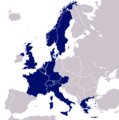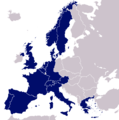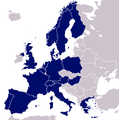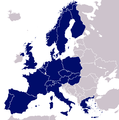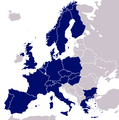CERN: Difference between revisions
→Current complex: experiment within the ISOLDE complex |
incorrect name please see http://home.web.cern.ch/fr/about - the council name dates from was when it was being conceived it |
||
| Line 21: | Line 21: | ||
}} |
}} |
||
The '''European Council for Nuclear Research''' ({{lang-fr|link=no| |
The '''European Council for Nuclear Research''' ({{lang-fr|link=no|Organisation Européen pour la Recherche Nucléaire}}), known as '''CERN'''<!-- The acronym is explained in CERN's website: http://home.web.cern.ch/about --> ({{IPAc-en|ˈ|s|ɝ|n}}; {{IPA-fr|sɛʁn}}; see [[#History|''History'']]) is a European research organization whose purpose is to operate the world's largest [[particle physics]] laboratory. Established in 1954, the organization is based in the northwest suburbs of [[Geneva]] on the Franco–Swiss border, ({{coord|46|14|3|N|6|3|19|E}}) and has 21 European [[#Member States|member states]]. [[Israel]] is the first (and currently only) non-European country granted full membership.<ref>[http://www.haaretz.com/news/features/david-s-harp/.premium-1.564168 The boycott movement is losing the battle - for now]</ref> |
||
The term CERN is also used to refer to the laboratory, which employs just under 2,400 full-time employees and 1,500 part-time employees, and hosts some 10,000 visiting scientists and engineers, representing 608 universities and research facilities and 113 nationalities.{{citation needed|date=March 2013}} |
The term CERN is also used to refer to the laboratory, which employs just under 2,400 full-time employees and 1,500 part-time employees, and hosts some 10,000 visiting scientists and engineers, representing 608 universities and research facilities and 113 nationalities.{{citation needed|date=March 2013}} |
||
Revision as of 16:13, 10 July 2014
46°14′03″N 6°03′10″E / 46.23417°N 6.05278°E
| File:CERN official logo.jpg | |
 Member states | |
| Formation | 29 September 1954[1] |
|---|---|
| Headquarters | Meyrin, Canton de Genève, Switzerland |
Membership | 21 member states and 7 observers |
Official languages | English and French |
| Rolf-Dieter Heuer | |
| Website | cern.ch |
The European Council for Nuclear Research (French: Organisation Européen pour la Recherche Nucléaire), known as CERN (/ˈsɜːrn/; French pronunciation: [sɛʁn]; see History) is a European research organization whose purpose is to operate the world's largest particle physics laboratory. Established in 1954, the organization is based in the northwest suburbs of Geneva on the Franco–Swiss border, (46°14′3″N 6°3′19″E / 46.23417°N 6.05528°E) and has 21 European member states. Israel is the first (and currently only) non-European country granted full membership.[2]
The term CERN is also used to refer to the laboratory, which employs just under 2,400 full-time employees and 1,500 part-time employees, and hosts some 10,000 visiting scientists and engineers, representing 608 universities and research facilities and 113 nationalities.[citation needed]
CERN's main function is to provide the particle accelerators and other infrastructure needed for high-energy physics research – as a result, numerous experiments have been constructed at CERN following international collaborations. It is also the birthplace of the World Wide Web. The main site at Meyrin has a large computer centre containing powerful data-processing facilities, primarily for experimental-data analysis; because of the need to make these facilities available to researchers elsewhere, it has historically been a major wide area networking hub.
History

The convention establishing CERN was ratified on 29 September 1954 by 12 countries in Western Europe.[1] The acronym CERN originally stood in French for Conseil Européen pour la Recherche Nucléaire (European Council for Nuclear Research), which was a provisional council for setting up the laboratory, established by 12 European governments in 1952. The acronym was retained for the new laboratory after the provisional council was dissolved, even though the name changed to the current Organisation Européenne pour la Recherche Nucléaire (European Organization for Nuclear Research) in 1954.[3] According to Lew Kowarski, a former director of CERN, when the name was changed, the acronym could have become the awkward OERN, and Heisenberg said that the acronym could "still be CERN even if the name is [not]".[citation needed]
Soon after the laboratory's establishment, its work went beyond the study of the atomic nucleus into higher-energy physics, which is concerned mainly with the study of interactions between particles. Therefore the laboratory operated by CERN is commonly referred to as the European laboratory for particle physics (Laboratoire européen pour la physique des particules) which better describes the research being performed at CERN.
Scientific achievements
Several important achievements in particle physics have been made during experiments at CERN. They include:
- 1973: The discovery of neutral currents in the Gargamelle bubble chamber;[4]
- 1983: The discovery of W and Z bosons in the UA1 and UA2 experiments;[5]
- 1989: The determination of the number of light neutrino families at the Large Electron–Positron Collider (LEP) operating on the Z boson peak;
- 1995: The first creation of antihydrogen atoms in the PS210 experiment;[6]
- 1999: The discovery of direct CP violation in the NA48 experiment;[7]
- 2010: The isolation of 38 atoms of antihydrogen;[8]
- 2011: Maintaining antihydrogen for over 15 minutes;[9]
- 2012: A boson with mass around 125 GeV/c2 consistent with long-sought Higgs boson.[10]
The 1984 Nobel Prize in physics was awarded to Carlo Rubbia and Simon van der Meer for the developments that led to the discoveries of the W and Z bosons. The 1992 Nobel Prize in physics was awarded to CERN staff researcher Georges Charpak "for his invention and development of particle detectors, in particular the multiwire proportional chamber."
Computer science
The World Wide Web began as a CERN project called ENQUIRE, initiated by Tim Berners-Lee in 1989 and Robert Cailliau in 1990.[11] Berners-Lee and Cailliau were jointly honoured by the Association for Computing Machinery in 1995 for their contributions to the development of the World Wide Web.
Based on the concept of hypertext, the project was aimed at facilitating sharing information among researchers. The first website went on-line in 1991. On 30 April 1993, CERN announced that the World Wide Web would be free to anyone. A copy[12] of the original first webpage, created by Berners-Lee, is still published on the World Wide Web Consortium's website as a historical document.
Prior to the Web's development, CERN had been a pioneer in the introduction of Internet technology, beginning in the early 1980s. A short history of this period can be found at CERN.ch.[13]
More recently, CERN has become a centre for the development of grid computing, hosting projects including the Enabling Grids for E-sciencE (EGEE) and LHC Computing Grid. It also hosts the CERN Internet Exchange Point (CIXP), one of the two main internet exchange points in Switzerland.
Faster-than-light neutrino anomaly
On 22 September 2011, the OPERA Collaboration reported the detection of 17-GeV and 28-GeV muon neutrinos, sent 730 kilometers (450 miles) from CERN near Geneva, Switzerland to the Gran Sasso National Laboratory in Italy, traveling apparently faster than light by a factor of 2.48×10−5 (approximately 1 in 40,000), a statistic with 6.0-sigma significance.[14] However, in March 2012 it was reported by a new team of scientists for CERN, Icarus, that the previous experiment was most likely flawed and will be retested by scientists of both the Opera and Icarus teams;[15] on 16 March, CERN stated in a press release that the results were flawed due to an incorrectly connected GPS-synchronization cable.[16]
Particle accelerators
Current complex

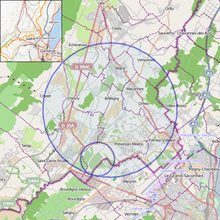
CERN operates a network of six accelerators and a decelerator. Each machine in the chain increases the energy of particle beams before delivering them to experiments or to the next more powerful accelerator. Currently active machines are:
- Two linear accelerators generate low energy particles. Linac2 accelerates protons to 50 MeV for injection into the Proton Synchrotron Booster (PSB), and Linac3 provides heavy ions at 4.2 MeV/u for injection into the Low Energy Ion Ring (LEIR).[17]
- The Proton Synchrotron Booster increases the energy of particles generated by the proton linear accelerator before they are transferred to the other accelerators.
- The Low Energy Ion Ring (LEIR) accelerates the ions from the ion linear accelerator, before transferring them to the Proton Synchrotron (PS). This accelerator was commissioned in 2005, after having been reconfigured from the previous Low Energy Antiproton Ring (LEAR).
- The 28 GeV Proton Synchrotron (PS), built in 1959 and still operating as a feeder to the more powerful SPS.
- The Super Proton Synchrotron (SPS), a circular accelerator with a diameter of 2 kilometres built in a tunnel, which started operation in 1976. It was designed to deliver an energy of 300 GeV and was gradually upgraded to 450 GeV. As well as having its own beamlines for fixed-target experiments (currently COMPASS and NA62), it has been operated as a proton–antiproton collider (the SppS collider), and for accelerating high energy electrons and positrons which were injected into the Large Electron–Positron Collider (LEP). Since 2008, it has been used to inject protons and heavy ions into the Large Hadron Collider (LHC).
- The On-Line Isotope Mass Separator (ISOLDE), which is used to study unstable nuclei. The radioactive ions are produced by the impact of protons at an energy of 1.0–1.4 GeV from the Proton Synchrotron Booster. It was first commissioned in 1967 and was rebuilt with major upgrades in 1974 and 1992.
- The Antiproton Decelerator (AD), which reduces the velocity of antiprotons to about 10% of the speed of light for research into antimatter.
- The Compact Linear Collider Test Facility, which studies feasibility issues for the future normal conducting linear collider project.
Large Hadron Collider
Most of the activities at CERN are currently directed towards operating the new Large Hadron Collider (LHC), and the experiments for it. The LHC represents a large-scale, worldwide scientific cooperation project.
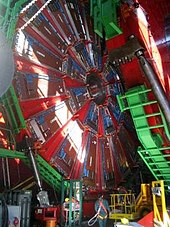
The LHC tunnel is located 100 metres underground, in the region between the Geneva International Airport and the nearby Jura mountains. It uses the 27 km circumference circular tunnel previously occupied by LEP which was closed down in November 2000. CERN's existing PS/SPS accelerator complexes will be used to pre-accelerate protons which will then be injected into the LHC.
Seven experiments (CMS, ATLAS, LHCb, MoEDAL,[18] TOTEM, LHC-forward and ALICE) will run on the collider; each of them will study particle collisions from a different point of view, and with different technologies. Construction for these experiments required an extraordinary engineering effort. Just as an example, a special crane had to be rented from Belgium in order to lower pieces of the CMS detector into its underground cavern, since each piece weighed nearly 2,000 tons. The first of the approximately 5,000 magnets necessary for construction was lowered down a special shaft at 13:00 GMT on 7 March 2005.
This accelerator has begun to generate vast quantities of data, which CERN streams to laboratories around the world for distributed processing (making use of a specialised grid infrastructure, the LHC Computing Grid). In April 2005, a trial successfully streamed 600 MB/s to seven different sites across the world. If all the data generated by the LHC is to be analysed, then scientists must achieve 1,800 MB/s before 2008.
The initial particle beams were injected into the LHC August 2008.[19] The first attempt to circulate a beam through the entire LHC was at 8:28 GMT on 10 September 2008,[20] but the system failed because of a faulty magnet connection, and it was stopped for repairs on 19 September 2008.
The LHC resumed operation on Friday 20 November 2009 by successfully circulating two beams, each with an energy of 3.5 trillion electron volts. The challenge that the engineers then faced was to try to line up the two beams so that they smashed into each other. This is like "firing two needles across the Atlantic and getting them to hit each other" according to the LHC's main engineer Steve Myers, director for accelerators and technology at the Swiss laboratory.
At 1200 BST on Tuesday 30 March 2010 the LHC successfully smashed two proton particle beams travelling with 3.5 TeV (trillion electron volts) of energy, resulting in a 7 TeV event. However, this was just the start of the road toward the expected discovery of the Higgs boson. When the 7 TeV experimental period ended, the LHC revved up to 8 TeV (4 TeV acceleration in both directions) in March 2012, and soon began particle collisions at that rate. In early 2013 the LHC was shut down for a two-year maintenance period, to strengthen the huge magnets inside the accelerator. Eventually it will attempt to create 14 TeV events. In July 2012, CERN scientists announced the discovery of a new sub-atomic particle that could be the much sought after Higgs boson believed to be essential for formation of the Universe.[21]
Decommissioned accelerators
- The original linear accelerator (LINAC 1).
- The 600 MeV Synchrocyclotron (SC) which started operation in 1957 and was shut down in 1991.
- The Intersecting Storage Rings (ISR), an early collider built from 1966 to 1971 and operated until 1984.
- The Large Electron–Positron Collider (LEP), which operated from 1989 to 2000 and was the largest machine of its kind, housed in a 27 km-long circular tunnel which now houses the Large Hadron Collider.
- The Low Energy Antiproton Ring (LEAR), commissioned in 1982, which assembled the first pieces of true antimatter, in 1995, consisting of nine atoms of antihydrogen. It was closed in 1996, and superseded by the Antiproton Decelerator.
Sites


The smaller accelerators are on the main Meyrin site (also known as the West Area), which was originally built in Switzerland alongside the French border, but has been extended to span the border since 1965. The French side is under Swiss jurisdiction and there is no obvious border within the site, apart from a line of marker stones. There are six entrances to the Meyrin site:[citation needed]
- A, in Switzerland, for all CERN personnel at specific times.
- B, in Switzerland, for all CERN personnel at all times. Often referred to as the main entrance.
- C, in Switzerland, for all CERN personnel at specific times.
- D, in Switzerland, for goods reception at specific times.
- E, in France, for French-resident CERN personnel at specific times. Controlled by customs personnel. Named "Porte Charles de Gaulle" in recognition of his role in the creation of CERN.[22]
- Tunnel entrance, in France, for equipment transfer to and from CERN sites in France by personnel with a specific permit. This is the only permitted route for such transfers. Under the CERN treaty, no taxes are payable when such transfers are made. Controlled by customs personnel.
The SPS and LEP/LHC tunnels are almost entirely outside the main site, and are mostly buried under French farmland and invisible from the surface. However, they have surface sites at various points around them, either as the location of buildings associated with experiments or other facilities needed to operate the colliders such as cryogenic plants and access shafts. The experiments are located at the same underground level as the tunnels at these sites.
Three of these experimental sites are in France, with ATLAS in Switzerland, although some of the ancillary cryogenic and access sites are in Switzerland. The largest of the experimental sites is the Prévessin site, also known as the North Area, which is the target station for non-collider experiments on the SPS accelerator. Other sites are the ones which were used for the UA1, UA2 and the LEP experiments (the latter which will be used for LHC experiments).
Outside of the LEP and LHC experiments, most are officially named and numbered after the site where they were located. For example, NA32 was an experiment looking at the production of charmed particles and located at the Prévessin (North Area) site while WA22 used the Big European Bubble Chamber (BEBC) at the Meyrin (West Area) site to examine neutrino interactions. The UA1 and UA2 experiments were considered to be in the Underground Area, i.e. situated underground at sites on the SPS accelerator.
Most of the roads on the CERN campus are named after famous physicists, e.g.- Richard Feynman, Niels Bohr, Albert Einstein.
Participation and funding
Member states and budget

Since its foundation by 12 members in 1954, CERN regularly accepted new members. All new members have remained in the organisation continuously since their accession, except Spain and Yugoslavia. Spain first joined CERN in 1961, withdrew in 1969, and rejoined in 1983. Yugoslavia was a founding member of CERN but left in 1961. Initially only West Germany was a (founding) member of CERN. Of the twenty members, 18 are European Union member states. Switzerland and Norway are not. Israel joined CERN as a full member on 6 January 2014,[23] becoming the first (and currently only) non-European member.[24]
| Member state | Status since | Contribution (million CHF for 2014) |
Contribution (% for 2014) |
|---|---|---|---|
| Founding Members[note 1] | |||
| 29 September 1954 | 30.5 | 2.5% | |
| 29 September 1954 | 19.3 | 1.6% | |
| 29 September 1954 | 169.2 | 14.0% | |
| 29 September 1954 | 222.9 | 18.5% | |
| 29 September 1954 | 18.0 | 1.5% | |
| 29 September 1954 | 126.2 | 10.5% | |
| 29 September 1954 | 50.6 | 4.2% | |
| 29 September 1954 | 28.0 | 2.3% | |
| 29 September 1954 | 28.7 | 2.4% | |
| 29 September 1954 | 40.0 | 3.3% | |
| 29 September 1954 | 152.6 | 12.7% | |
| Acceded Members[note 2] | |||
| 1 June 1959 | 24.4 | 2.0% | |
| 1 January 1983 | 91.1 | 7.6% | |
| 1 January 1986 | 13.2 | 1.1% | |
| 1 January 1991 | 15.3 | 1.3% | |
| 1 July 1991 | 29.3 | 2.4% | |
| 1 July 1992 | 7.1 | 0.6% | |
| 1 July 1993 | 11.3 | 0.9% | |
| 1 July 1993 | 5.5 | 0.5% | |
| 11 March 1999 | 3.1 | 0.3% | |
| 6 January 2014[23] | 22.1 | 1.8% | |
| Candidate Member[note 3] | |||
| 11 February 2010[28] | 7.9 | 0.7% | |
| Associate Member in the pre-stage to Membership[note 3] | |||
| 15 March 2012[29] | 1.0 | 0.1% | |
| Associate Members | |||
| 5 October 2012[30] | % | ||
| 3 October 2013[31] | % | ||
| 12 May 2014[32] | % | ||
| 19 June 2014[33] | % | ||
| Total Members, Candidates and Associates | 1,117.5[34] | 92.7% | |
| 1 July 1985[36] | 18.8 | 1.6% | |
| Other income | — | 69.2 | 5.7% |
| Total CERN | 1,205.5[35] | 100.0% | |
- ^ 12 founding members drafted the Convention for the Establishment of a European Organization for Nuclear Research which entered into force on 29 September 1954.[25][26]
- ^ Acceded members became CERN member states upon signing an accession agreement.[27]
- ^ a b Additional contribution from Candidates for Accession and Associate Member States.[27]
| Maps of the history of CERN membership |
|---|
|
Enlargement
Associate Members, Candidates (note that dates are initial signature, not of ratification):
 Romania, first approved by CERN Council in December 2008,[37] became a candidate for accession to CERN on 11 February 2010[28] and will become a full member in 2015.[38]
Romania, first approved by CERN Council in December 2008,[37] became a candidate for accession to CERN on 11 February 2010[28] and will become a full member in 2015.[38] Serbia became a candidate for accession to CERN on 19 December 2011, signed an association agreement on 10 January 2012[39][40] and became an official "Associate Member in the pre-stage to Membership" on 15 March 2012.[29]
Serbia became a candidate for accession to CERN on 19 December 2011, signed an association agreement on 10 January 2012[39][40] and became an official "Associate Member in the pre-stage to Membership" on 15 March 2012.[29] Cyprus became an associate member on 5 October 2012.[30]
Cyprus became an associate member on 5 October 2012.[30] Ukraine became an associate member on 3 October 2013.[31]
Ukraine became an associate member on 3 October 2013.[31] Brazil was approved by CERN Council on 13 December 2013[41] to become the first Latin American associate member. As of July 2014[update], Brazil still needs to sign and ratify its accession agreement.[42]
Brazil was approved by CERN Council on 13 December 2013[41] to become the first Latin American associate member. As of July 2014[update], Brazil still needs to sign and ratify its accession agreement.[42] Turkey became an associate member on 12 May 2014.[32]
Turkey became an associate member on 12 May 2014.[32] Pakistan became an associate member on 19 June 2014. [33]
Pakistan became an associate member on 19 June 2014. [33]
More countries have confirmed their wish to become members and are awaiting approval from the CERN Council:[43]
 Slovenia, which cooperates scientifically with CERN since 1991, applied for membership in 2009.[44]
Slovenia, which cooperates scientifically with CERN since 1991, applied for membership in 2009.[44] Russia, working with CERN in practice since 1959 (as the former Soviet Union) and currently an observer state, formally applied for membership in 2012.[45]
Russia, working with CERN in practice since 1959 (as the former Soviet Union) and currently an observer state, formally applied for membership in 2012.[45]
International relations
Four countries have observer status:[46]
Also observers are the following international organizations:
 UNESCO – since 1954
UNESCO – since 1954 European Commission – since 1985
European Commission – since 1985
Non-Member States (with dates of Co-operation Agreements) currently involved in CERN programmes are:
CERN also has scientific contacts with the following countries:[52]
International research institutions, such as CERN, can aid in science diplomacy.[53]
Public exhibits

Facilities at CERN open to the public include:
- The Globe of Science and Innovation, which opened in late 2005 and is used four times a week for special exhibits.
- The Microcosm museum on particle physics and CERN history.
- The Hindu deity, Shiva, a 2 metre statue styled on Chola bronzes of the deity engaging in the Nataraja dance of Chidambaram, parallelling the movements or "dance" of subatomic particles.[54][55][56]
In popular culture

- CERN's Large Hadron Collider is the subject of a (scientifically accurate) rap video starring Katherine McAlpine with some of the facility's staff.[57][58]
- CERN is depicted in an episode of South Park (Season 13, Episode 6) called "Pinewood Derby". Randy Marsh, the father of one of the main characters, breaks into the "Hadron Particle Super Collider in Switzerland" and steals a "superconducting bending magnet created for use in tests with particle acceleration" to use in his son Stan's Pinewood Derby racer. Randy breaks into CERN dressed in disguise as Princess Leia from the Star Wars saga. The break-in is captured on surveillance tape which is then broadcast on the news.[59]
- John Titor, a self-proclaimed time traveler, alleged that CERN would invent time travel in 2001.
- CERN is depicted in the visual novel/anime series Steins;Gate as SERN, a shadowy organization that has been researching time travel in order to restructure and control the world.
- In Dan Brown's mystery-thriller novel Angels & Demons, a canister of antimatter is stolen from CERN.[60]
- In the popular children's series The 39 Clues, CERN is said to be an Ekaterina stronghold hiding the clue hydrogen.
- In Robert J. Sawyer's science fiction novel Flashforward, at CERN, the Large Hadron Collider accelerator is performing a run to search for the Higgs boson when the entire human race sees themselves twenty-one years and six months in the future.
- In season 3 episode 15 of the popular TV sitcom The Big Bang Theory titled "The Large Hadron Collision", Leonard and Rajesh travel to CERN to attend a conference and see the LHC.
- The 2012 student film Decay, which centers around the idea of the Large Hadron Collider transforming people into zombies, was filmed on location in CERN's maintenance tunnels.[61]
- The Compact Muon Solenoid at CERN was used as the basis for the Megadeth's Super Collider album cover.
- In Denpa Kyoushi, the main character is scouted by "CERM"
- In Super Lovers, Haruko (Ren's mother) worked at CERN, and Ren was taught by CERN professors
Associated institutions
This section needs expansion. You can help by adding to it. (October 2013) |
See also
- CERN Openlab
- Fermilab
- Nederlandse Organisatie voor Wetenschappelijk Onderzoek
- Science and technology in Switzerland
- Scientific Linux
- SLAC National Accelerator Laboratory
- World Wide Web
- Template:Wikipedia books link
References
- ^ a b c "CERN.ch". Public.web.cern.ch. Retrieved 20 November 2010.
- ^ The boycott movement is losing the battle - for now
- ^ "The Name CERN". CERN. 30 September 2011. Retrieved 16 August 2012.
- ^ "CERN.ch". Public.web.cern.ch. Retrieved 20 November 2010.
- ^ "CERN.ch La". Public.web.cern.ch. Retrieved 20 November 2010.
- ^ "CERN.ch". Public.web.cern.ch. Retrieved 20 November 2010.
- ^ Fanti, V.; et al. (1998). "A new measurement of direct CP violation in two pion decays of the neutral kaon". Physics Letters B. 465: 335. arXiv:hep-ex/9909022. Bibcode:1999PhLB..465..335F. doi:10.1016/S0370-2693(99)01030-8.
- ^ "Antihydrogen isolation". CNN. 18 November 2010.
- ^ Jonathan Amos [6 June 2011]BBC © 2011 Retrieved 2011-06-06
- ^ CERN experiments observe particle consistent with long-sought Higgs boson | CERN press office. Press.web.cern.ch (2012-07-04). Retrieved on 2013-07-17.
- ^ "CERN.ch". Public.web.cern.ch. Retrieved 20 November 2010.
- ^ "W3.org". W3.org. Retrieved 20 November 2010.
- ^ "CERN.ch". CERN.ch. Retrieved 20 November 2010.
- ^ Adrian Cho, Neutrinos Travel Faster Than Light, According to One Experiment, Science NOW, 22 September 2011.
- ^ The Associated Press, "Einstein Proved Right in Retest of Neutrinos' Speed", The Associated Press, 17 March 2012.
- ^ "CERN Press Release". Press.web.cern.ch. Retrieved 4 July 2012.
- ^ "CERN Website – LINAC". Linac2.home.cern.ch. Retrieved 20 November 2010.
- ^ CERN Courier, "MoEDAL becomes the LHC's magnificent seventh", 5 May 2010
- ^ Overbye, Dennis (29 July 2008). "Let the Proton Smashing Begin. (The Rap Is Already Written.)". The New York Times.
- ^ "CERN press release, 7 August 2008". Press.web.cern.ch. 7 August 2008. Retrieved 20 November 2010.
- ^ "'God particle': New particle found, could be the Higgs boson, CERN scientists say". The Times Of India. 4 July 2012.
- ^ <Please add first missing authors to populate metadata.> (November 2004). "Red Carpet for CERN's 50th". CERN bulletin.
- ^ a b "CERN Internationl Relations - Israel". Retrieved 5 July 2014.
- ^ Rahman, Fazlur. (2013-11-11) Israel may become first non-European member of nuclear research group CERN - Diplomacy and Defense Israel News. Haaretz. Retrieved on 2014-04-28.
- ^ ESA Convention (PDF) (6th ed.). European Space Agency. September 2005. ISBN 92-9092-397-0.
- ^ "CONVENTION FOR THE ESTABLISHMENT OF A EUROPEAN ORGANIZATION FOR NUCLEAR RESEARCH". CERN Council website. CERN. Retrieved 16 July 2012.
- ^ a b "CERN Member States". CERN Council website. CERN. Retrieved 16 July 2012.
- ^ a b "Romania takes first steps to join CERN". CERN Courier. CERN. 31 March 2010. Retrieved 5 July 2014.
- ^ a b "CERN Associate Members". CERN. 16 March 2012. Retrieved 5 July 2014.
- ^ a b "The Republic of Cyprus becomes a CERN Associate Member State". CERN press release. CERN. 5 October 2012. Retrieved 5 July 2014.
- ^ a b "Ukraine to become Associate Member State of CERN". CERN press release. CERN. 3 October 2013. Retrieved 5 July 2014.
- ^ a b "Turkey to become Associate Member State of CERN". CERN press release. CERN. 12 May 2014. Retrieved 5 July 2014.
- ^ a b "Pakistan Becomes the First Associate CERN Member from Asia". Government of Pakistan press releases. Ministry of Foreign Affairs, Government of Pakistan. 20 June 2014. Retrieved 5 July 2014.
- ^ "Member States' Contributions - 2014". CERN website. CERN. Retrieved 6 July 2014.
- ^ a b "Final Budget of the Organization for the sixtieth financial year 2014" (PDF). CERN. 29 November 2013. Retrieved 6 July 2014.
- ^ "Observers". CERN Council website. CERN. Retrieved 16 July 2012.
- ^ "CERN International Relations - Romania". CERN. 3 April 2013. Retrieved 5 July 2014.
- ^ Andresen, G. B.; et al. (2010). "Trapped antihydrogen". Nature. 468 (7324): 673–6. Bibcode:2010Natur.468..673A. doi:10.1038/nature09610. PMID 21085118.
- ^ "Vesti - Srbija zvanično postala član CERN-a". B92. Retrieved 4 July 2012.
- ^ "Serbia expected to become CERN Associate Member". CMS Experiment web site. CERN. 18 January 2012. Retrieved 5 July 2014.
- ^ "Decisions from CERN Council's 169th session". 13 December 2013. Retrieved 5 July 2014.
- ^ "Brasil fará parte do maior laboratório de física do Mundo". www.estadao.com.br. 13 December 2013. Retrieved 21 December 2013.
- ^ "24 June 2011: CERN - CERN Council looks forward to summer conferences and new members". Interactions.org. 24 June 2011. Retrieved 7 December 2011.
- ^ "CERN International Relations - Slovenia". CERN. 24 January 2014. Retrieved 5 July 2014.
- ^ "Russia officially joins CERN at last". swissinfo.ch. 1 October 2013. Retrieved 5 July 2014.
- ^ "ISAAR relationship data at CERN library". Retrieved 14 December 2009.
- ^ "CERN International Relations - Jordan". International-relations.web.cern.ch. Retrieved 4 July 2012.
- ^ "CERN International Relations - SESAME". International-relations.web.cern.ch. 17 October 2011. Retrieved 4 July 2012.
- ^ "''Macedonia joins CERN (SUP)''". Mia.com.mk. Retrieved 20 November 2010.
- ^ "Prime Minister of Malta visits CERN". CERN Bulletin. 10 January 2008. Retrieved 23 May 2014.
- ^ "Malta signs agreement with CERN". Times of Malta. 11 January 2008. Retrieved 23 May 2014.
- ^ "Member states". CERN. Retrieved 23 May 2014.
- ^ Quevedo, Fernando (July 2013). "The Importance of International Research Institutions for Science Diplomacy". Science & Diplomacy. 2 (3).
- ^ "Shiva's Cosmic Dance at CERN". Fritjof Capra. 18 June 2004. Retrieved 7 December 2011.
- ^ Ramachandran, Nirmala (2000). Hindu heritage. Pannipitiya : Stamford Lake Publication, 2000-2002. pp. 41–42. ISBN 978-955-8156-43-8.
- ^ Smith, David. The Dance of Siva: Religion, Art and Poetry in South India. Cambridge University Press. ISBN 978-0-521-52865-8.
- ^ "Youtube.com". Youtube. Retrieved 20 November 2010.
- ^ "Large Hadron Collider Rap Video Is a Hit", National Geographic News. 10 September 2008. Retrieved 13 August 2010.
- ^ "Southparkstudios.com". South Park Studios. Retrieved 25 May 2011.
- ^ "Angels and Demons". CERN. Retrieved 31 January 2012.
- ^ Boyle, Rebecca (31 October 2012). "Large Hadron Collider Unleashes Rampaging Zombies". Retrieved 22 November 2012.
External links
- Official website of CERN: CERN Accelerating science
- CERN at 50
- CERN Courier – International journal of high-energy physics
- Israel may become first non-European member of nuclear research group CERN
- Big Bang Day: The Making of CERN, September 2008, A BBC Radio program
- Use dmy dates from October 2012
- CERN
- International organizations of Europe
- International research institutes
- Meyrin
- Nuclear research centers
- Organisations based in Geneva
- Organizations established in 1954
- Particle physics facilities
- Physics institutes
- Research institutes in Switzerland
- Science and technology in Europe

![1954 (12 members): CERN is founded [a] (1989 borders)](http://upload.wikimedia.org/wikipedia/commons/thumb/6/6e/Cernfounders.png/119px-Cernfounders.png)


